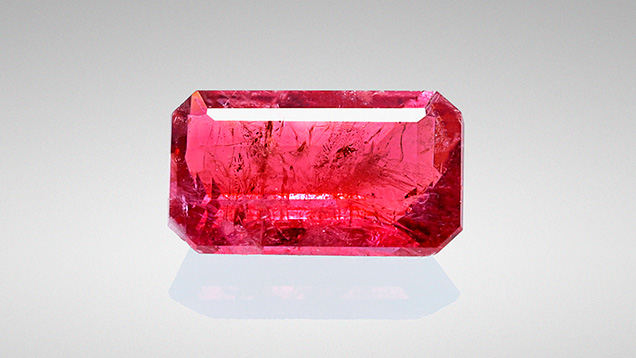Topaz Crystals in Red Beryl

Gem-quality beryl comes in various colors, including green, yellow, pink, and rarely red, which has only been mined in the state of Utah to date. Recently, a red beryl (figure 1) was submitted to Guild Gem Laboratories in Shenzhen for identification. This emerald-cut sample weighed 0.22 ct and exhibited a highly saturated red color. The refractive index values of 1.562–1.569 and birefringence of 0.007 were consistent with beryl. Multiple analytical methods were applied, including FTIR and UV-Vis-NIR spectroscopy, and EDXRF for chemical analysis. FTIR confirmed the sample as beryl (figure 2), and the UV-Vis-NIR spectrum showed a prominent manganese-related broad band centered at 540 nm, as well as a weak iron-inducted band at 370 nm (figure 3).


EDXRF results showed that the beryl was rich in iron (16920 ppm) and manganese (2586 ppm), along with a trace amount of zinc (787 ppm). Such results were very close to previously reported values for red beryl from the Wah Wah Mountains of Utah: 15000 ppm iron, 2000 ppm manganese, and 700 ppm zinc, respectively (J.E. Shigley and E.E. Foord, “Gem-quality red beryl from the Wah Wah Mountains, Utah,” Winter 1984 G&G, pp. 208–221).


Microscopic observation revealed several two-phase fluid inclusions along the healed fissures, and purple-blue flashes were clearly seen within the open fissures, which indicated clarity enhancement by organic fillers. This was confirmed by FTIR, with peaks at 2854, 2871, 2927, and 2963 cm–1. Two transparent crystal inclusions were present and exposed to the surface near the girdle, showing a prismatic crystal habit (figure 4). Within the included crystals, a series of cleavage layers were prominent. Further testing by micro-confocal Raman spectroscopy in the 100–1200 cm–1 range showed distinct peaks at 240, 267, 285, 332, 430, 456, and 927 cm–1, results that agree with topaz according to the RRUFF online database (figure 5).
Topaz rhyolites are widely distributed across the western United States, and red beryl occurs in topaz-bearing rhyolites (J.E. Shigley et al., “Red beryl from Utah: A review and update,” Winter 2003 G&G, pp. 302–313). Hence, it is not surprising to see topaz as a mineral inclusion in red beryl, although such an observation does not appear to have been reported before.



